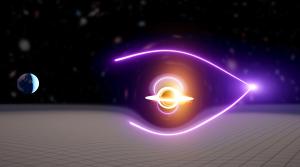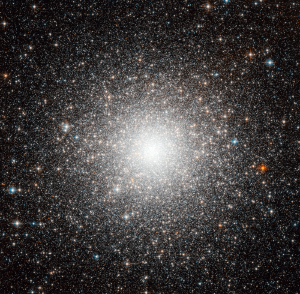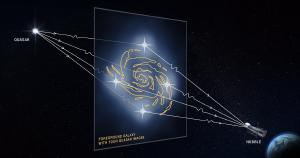Blog
Coming to a Middle
7 April 2021
 Carl Knox, OzGrav
Carl Knox, OzGravBlack holes come in three sizes: small, medium, and large. Small black holes are of stellar mass. They form when a large star collapses at the end of its life. Large black holes lurk in the centers of galaxies and are millions or billions of solar masses. Middle-sized black holes are those between 100 to 100,000 solar masses. They are known as Intermediate Mass Black Holes (IMBHs), and they are the kind we least understand.
 ESA/Hubble & NASA
ESA/Hubble & NASAOne of the biggest difficulties in studying IMBHs is that they are difficult to find. We think they are formed when large stars or stellar-mass black holes merge in the centers of globular clusters, so they tend to be obscured within a dense cluster of bright stars. Intermediate black holes usually aren’t active, so we also can’t identify them by their jets or intense x-rays. But they should be fairly common. It’s estimated that about 45,000 intermediate-mass black holes could be in the vicinity of our galaxy.
Recently a team has used a new technique to find one of them.1 Their method uses gamma-ray bursts and gravitational lensing. A gamma ray burst (GRB) is a bright flash of gamma rays that occurs from time to time. They are likely caused when a large star explodes as a hypernova, or when two large stars collide and merge. Usually, a GRB will occur as a single flash lasting about half a second, but sometimes we’ll see two flashes that are in the same general region of the sky at nearly the same time. Now that could just be random chance, but it’s more likely that the two flashes were caused by the same GRB, but appear as multiple flashes because of gravitational lensing.
 NASA, ESA and D. Player (STScI)
NASA, ESA and D. Player (STScI)The team analyzed the pattern and spectrum of the double burst to show that the second one was an echo of the first. This confirmed that the event was gravitationally lensed by a mass between us and the GRB. They then used the timing of the two bursts to calculate to determine the cause. They found the data was consistent with an intermediate-mass black hole of about 55,000 solar masses.
This method can’t be used to find lots of intermediate-mass black holes, but every IMBH we find gives us another source of information. Intermediate mass black holes in the early universe may have been the seeds of the supermassive black holes we see in galaxies today. The more we understand about the middle children of the black hole family, the more we can how black holes helped shape our modern universe.
Paynter, James, Rachel Webster, and Eric Thrane. “Evidence for an intermediate-mass black hole from a gravitationally lensed gamma-ray burst.” Nature Astronomy (2021): 1-9. ↩︎